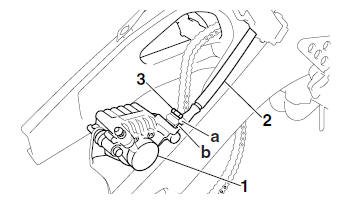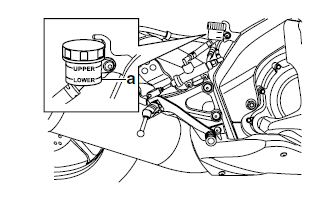Yamaha YZF-R125 Service Manual: Installing the rear brake caliper
1. Install:
- Brake caliper "1"

- Copper washers
- Brake hose "2"
- Union bolt "3"

| WARNING Proper brake hose routing is essential to insure safe vehicle operation. Refer to "CABLE ROUTING" on page 2-33. |
| CAUTION: When installing the brake hose onto the brake caliper, be sure to position the brake pipe "a" into the slot "b" in the brake caliper. |

2. Install:
- Brake pad spring
- Brake pads
- Brake pad retaining bolts
- Rear brake caliper
Refer to "REPLACING THE REAR BRAKE
PADS" on page 4-33.

3. Install:
- Rear wheel Refer to "REAR WHEEL" on page 4-12.
4. Fill:
- Brake fluid reservoir
(with the specified amount of the recommended
brake fluid)

WARNING
|
| CAUTION: Brake fluid may damage painted surfaces and plastic parts. Therefore, always clean up any spilt brake fluid immediately. |
5. Bleed:
- Brake system Refer to "BLEEDING THE HYDRAULIC BRAKE SYSTEM" on page 3-20.
6. Check:
- Brake fluid level
Below the minimum level mark "a"

Add the recommended brake fluid to the proper level.Refer to "CHECKING THE BRAKE FLUID LEVEL" on page 3-18.

7. Check:
- Brake pedal operation
Soft or spongy feeling
 Bleed
Bleed
the brake system.Refer to "BLEEDING THE HYDRAULIC BRAKE SYSTEM" on page 3-20.
 Assembling the rear brake caliper
Assembling the rear brake caliper
WARNING
Before installation, all internal brake components
should be cleaned and lubricated
with clean or new brake fluid.
Never use solvents on internal brake components
as ...
 Removing the rear brake master cylinder
Removing the rear brake master cylinder
NOTE:
Before removing the rear brake master cylinder,
drain the brake fluid from the entire brake system.
1. Disconnect:
Rear brake light switch coupler
2. Loosen:
Rear brake light switc ...
Other materials:
Checking the speed sensor
1. Check:
Speed sensor output voltage
Out of specification → Replace.
a. Connect the pocket tester (DC 20 V) to the
speed sensor coupler (wire harness end) as
shown.
Positive tester probe
gray "1"
Negative tester probe
gray/black "2"
b. Set the main switch to "ON".
c. ...
Supporting the motorcycle
Since this model is not equipped with a
centerstand, follow these precautions
when removing the front and rear
wheel or performing other maintenance
requiring the motorcycle to stand upright.
Check that the motorcycle is in a
stable and level position before starting
any maintenance. A ...
Cleaning and lubricating the drive chain
The drive chain must be cleaned and
lubricated at the intervals specified in
the periodic maintenance and lubrication
chart, otherwise it will quickly wear
out, especially when riding in dusty or
wet areas. Service the drive chain as
follows.
NOTICE
The drive chain must be lubricated
...
